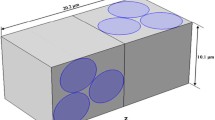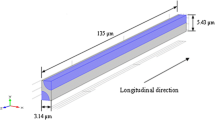Abstract
This paper describes mechanism-based modeling of damage evolution in high temperature polymer matrix composites (HTPMC) under thermo-oxidative aging conditions. Specifically, a multi-scale model based on micro-mechanics analysis in conjunction with continuum damage mechanics (CDM) is developed to simulate the accelerated fiber–matrix debond growth in the longitudinal direction of a unidirectional HTPMC. Using this approach, one can relate the behavior of composites at the micro-level (representative volume element) to the macro-level (structural element) in a computationally tractable manner. Thermo-oxidative aging is simulated with diffusion-reaction model in which temperature, oxygen concentration, and weight loss effects are considered. For debond growth simulation, a model based on Darcy’s laws for oxygen permeation in the fiber–matrix interface is employed, that, when coupled with polymer shrinkage, provides a mechanism for permeation-controlled debond growth in HTPMC. Benchmark of model prediction with experimental observations of oxidation layer growth is presented, together with a laminate thermo-oxidative life prediction model based on CDM to demonstrate proof-of-concept.










Similar content being viewed by others
References
Colin X, Verdu J (2005) Compos Sci Technol 65:411. doi:https://doi.org/10.1016/j.compscitech.2004.09.011
Colin X, Marais C, Verdu J (2005) Compos Sci Technol 65:117. doi:https://doi.org/10.1016/j.compscitech.2004.06.009
Tandon GP, Pochiraju KV, Schoeppner GA (2006) Polym Degrad Stab 91(8):1861. doi:https://doi.org/10.1016/j.polymdegradstab.2005.11.008
Pochiraju KV, Tandon GP (2006) J Eng Mater Technol 128:107. doi:https://doi.org/10.1115/1.2128427
Pochiraju KV, Tandon GP, Schoeppner GA (2008) Mech Time-Depend Mater 12:45. doi:https://doi.org/10.1007/s11043-007-9042-5
Wang SS, Chen X (2006) J Eng Mater Technol 128:81. doi:https://doi.org/10.1115/1.2132377
Talreja R (1991) Mech Mater 12:165. doi:https://doi.org/10.1016/0167-6636(91)90061-4
Talreja R (2006) J Mater Sci 41:6800. doi:https://doi.org/10.1007/s10853-006-0210-9
Crank J (1975) Mathematics of diffusion, 2nd edn. Clarendon Press, Oxford
Roy S, Wang Y, Park S, Liechti KM (2006) ASME J Eng Mater Technol 128(1):11. doi:https://doi.org/10.1115/1.2127959
Roy S, Wang Y, Park S, Xu D, Liechti KM (2007) J Mech Adv Mater Struct 14:1. doi:https://doi.org/10.1080/15376490600985227
Needleman A (1987) J Appl Mech 54:525
Wise J, Gillen KT, Clough RL (1997) Polymer 38:1929. doi:https://doi.org/10.1016/S0032-3861(96)00716-1
Williams JG (1984) Fracture mechanics of polymers. Ellis Horwood Limited
Coleman BD, Gurtin ME (1967) J Chem Phys 47:597
Smith GF (1982) Quart Appl Math 39:509
ABAQUS, Version 6.5 (2004) Hibbit, Karlsson, and Sorensen Inc., Providence, Rhode Island
Acknowledgements
The authors gratefully acknowledge the support of the Mechanics of Multifunctional Materials & Microsystems Program of the Air Force Office of Scientific Research, with Dr. Byung “Les” Lee as Program Manager.
Author information
Authors and Affiliations
Corresponding author
Rights and permissions
About this article
Cite this article
Roy, S., Singh, S. & Schoeppner, G.A. Modeling of evolving damage in high temperature polymer matrix composites subjected to thermal oxidation. J Mater Sci 43, 6651–6660 (2008). https://doi.org/10.1007/s10853-008-2691-1
Received:
Accepted:
Published:
Issue Date:
DOI: https://doi.org/10.1007/s10853-008-2691-1




